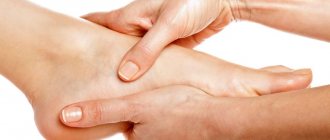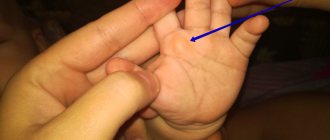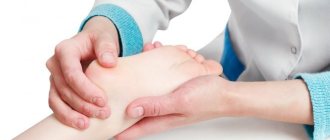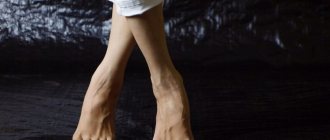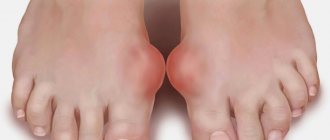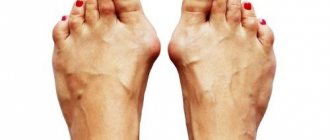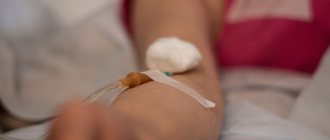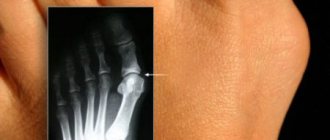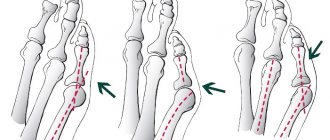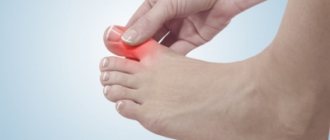Lumps, formations and other growths on the toes can appear at any time. If in winter and in the off-season they are practically invisible, then in summer the situation is different. In hot weather, this problem also becomes cosmetic. What could be growths on the toes, and how to get rid of them?
The growths can be a skin problem, or they can also appear as a result of diseases of the musculoskeletal system or other diseases, most often associated with metabolism. It is very important to diagnose formations correctly and timely. Only a specialist can do this correctly.
The same causes can have different types (this, for example, can be said about warts). And even more so, you should not prescribe medications or perform procedures that are not prescribed by a doctor, especially when it comes to a child.
Hallux valgus
In fact, it’s not even a growth, but a protrusion of the big toe, or a violation of the anatomy of the foot. In other words, this is an acquired skeletal deformity. For what reasons does this disease appear? It could be:
- Tight, uncomfortable shoes. When the foot remains in an uncomfortable position for a long time, the bones begin to shift so that they take on shapes similar in shape to a pair of shoes.
- Increased load. Most often we are talking about athletes. The risk group includes people who professionally lift weights (bodybuilding, weightlifting) or who have prolonged activity on their feet (dancers, football players). Increased load on the forefoot is also present in those women who prefer to walk in high heels. A pair of shoes leads to such consequences if the heel is over 5 cm.
Special correctors for the foot will allow you to restore the disturbed alignment of the bones in the big toe area, and the growth will gradually disappear
To correct the situation, you first need to eliminate the source, the cause of this condition. Of course, few people will decide to give up professional training, but you can temporarily limit the load. If it's all about the shoes, then you need to replace them with anatomically correct ones. By the way, it is absolutely not necessary to buy shoes in specialized stores, because they cost a lot of money there.
It is enough to purchase special correctors. They can be made of plastic or silicone and are inserted into shoes from the inside. Such correctors fix the finger in the correct position and evenly distribute the load. They should be worn for a long time, several months.
Over time, the arch of the foot will acquire its previous correct shape. Most likely, the patient will be prescribed a course of anti-inflammatory or painkillers, since hallux valgus is usually combined with other diseases (bursitis, arthrosis, etc.).
Rehabilitation
For some time after surgery, the patient is strictly forbidden to put any weight on the injured leg. For the first days, this is ensured by bed rest, after which the patient is allowed to walk using crutches. This can last from several weeks to several months, depending on the speed of tissue healing, the age of the patient and the presence of concomitant pathologies.
To speed up the healing process and restore full mobility of the foot, during the rehabilitation period experts recommend following a special regime for several months, including the following measures:
Taking medications - during the first time after surgery, the doctor prescribes the patient to take antibacterial, anti-inflammatory and painkillers;
Exercise therapy – you can begin therapeutic exercises for the foot only after the postoperative swelling of the tissues has passed. The exercise therapy complex is aimed at accelerating tissue healing, intensifying blood circulation and training the muscles and joints of the foot. Smooth flexion and extension of the toes are considered mandatory exercises in physical therapy;
Selection of the right shoes - the patient is advised to wear only properly selected, soft orthopedic shoes without heels, made from natural “breathable materials”. In addition to shoes, orthopedic insoles can be used to transfer the load from the forefoot to the heel, and special devices for separating the toes.
By strictly following the rules of the rehabilitation period, a few months after the operation the patient can return to an active lifestyle.
Dermatofibroma
This formation, unlike the previous one, has a solid structure. It often appears on the top of the fingers, on the back side. To diagnose it yourself, just try to collect a patch of skin in this place. If a dermatofibroma is present, the skin will pull inward into a fold.
Normally, this area of skin has a darker reddish tint. If the dermatofibroma grows to a large size, then in the center you can clearly see a tubercle, more solid in structure than the entire formation.
Causes of pain in toes
Causes of dermatofibroma:
- insect bite;
- untimely opened boils;
- penetration of foreign objects into the thickness of the skin.
Its main danger is that it has the ability to degenerate into dermatofibrosarcoma, and this is an oncological diagnosis with all that it implies. And, of course, it causes a lot of inconvenience to a person, preventing him from leading a normal active life. It is almost impossible to treat dermatofibrosarcoma at home.
The thing is that this formation lies deep under the thickness of the skin layers. It is most reliable to remove it using the traditional surgical method.
Modern removal methods
Modern medicine offers treatment options:
- Laser removal. A popular method, the effect on formations does not damage other tissues and joints. The treatment is painless. For a child, this is an ideal removal option.
- Cauterization with liquid nitrogen is used less often, after which the leg and fingers hurt, and the joints seem to ache. The centers of the disease are burning.
- At the initial stages, until the tubercle has penetrated the deep layers of tissue with threads, the spines are removed using thermocoagulation, which involves exposure to high-frequency currents.
You can try to remove the formations using folk remedies, which do not always give results. If after a week of home treatments you do not feel any results or the pain intensifies, you should urgently go to a dermatologist.
Warts
These benign formations appear on the toes quite often, but mainly in those individuals who have weakened immune systems. They look like calluses, but they are hard inside. And also on the top of warts you can see dark dots, these are dead blood vessels. Warts are not as harmless as they seem. This is not a simple cosmetic defect that prevents a person from wearing open shoes.
Warts cause severe pain when walking if there is friction between the skin and shoes. In the area of the fingers this happens extremely often. This can be observed especially often if the formation is located under the thumb or second finger. A person’s gait changes, and he intuitively tries to shift some of the load to other parts of the foot.
At an early stage, a wart looks like a small growth with a lump in the center. Gradually this growth becomes more obvious, its color darkens, and dark dots can be seen in the center of it
Sweating and elevated temperature only aggravate the situation and help in activating the human papillomavirus, which became the source of such formation on the toes. Pain and discomfort while walking lead to a change in a person’s gait, and this is a serious reason to immediately consult a doctor.
In addition, constant friction against this growth leads to microtraumas of the skin, and the epidermis becomes wounded and more permeable to many pathogens from the external environment. In addition to warts, a person may soon encounter fungi and streptoderma. If a wart appears near the nail, in the area of its base, then it can affect the size and shape of the nail and affect the rate of its growth.
Warts are treated in a specialized cosmetology office. You can choose the cryodestruction method, wave technique or laser. In some cases, if the location of the wart allows, it is removed surgically. The difficulty is that you need to completely remove the growth particles from the skin. Otherwise, after some time the wart will grow back.
There are also traditional methods of removing warts, which are no less effective. The most popular method is to periodically smear this area with fresh celandine juice. The juice should dry on its own. After two weeks of this therapy, the wart will dry out and begin to fall off. You can also use vinegar. Both regular and apple cider vinegar are suitable for these purposes.
You need to soak a cotton swab in vinegar and wipe the wart with it. You cannot pour vinegar directly onto the formation! This may cause skin burns. To prevent the growth of warts, it would be useful to take a course of antiviral drugs, but only a therapist should prescribe them. It is not always possible to cure warts completely. It is important to monitor your immunity, because this is the only way to prevent the activation of the virus.
Treatment with traditional methods
There are traditional medicine methods to cure growths based on the use of natural remedies:
- Baths. Soak your feet daily in a bath of hot water combined with a tablespoon of salt and 10 drops of iodine solution. Such baths will help remove and remove unwanted colonies of microorganisms and fungi on the feet.
- Apple vinegar. Wipe the growth with undiluted liquid 2 times a day.
- Celandine. Freshly squeezed celandine juice is applied to a bump or wart 2 or 3 times a day, which allows you to get rid of warts.
- Vegetable oil. Oil will help heal the tumor site. Wipe the area with dampened cotton wool until complete recovery.
- Butter and watercress. A paste of watercress juice and butter is applied to the growth several times a day.
Salt foot baths
Calluses
On the foot, they most often appear in the area of the heel and toes, that is, exactly where the skin rubs when walking. The appearance of calluses in the toes most often indicates increased stress on the forefoot. It can be assumed that the patient likes to wear high heels.
Wet calluses cause a lot of problems. The skin in this place stings and aches. Walking normally and even standing is very painful. It is especially dangerous if the contents of a wet callus are revealed. Where a sufficient layer of new skin has not yet formed, increased tissue permeability is observed. Pathogens from the external environment can enter the bloodstream.
Treatment of calluses involves applying an antiseptic patch. It is advisable to periodically remove the patch to allow the callus to dry out. If calluses appear periodically, from time to time, then most likely the problem is the wrong shoes, and they need to be replaced.
A wet callus looks like a growth with clear outlines and liquid contents. It is advisable to protect this area from mechanical damage as long as possible to prevent the callus from bursting.
Corns
Most often they appear on the big and index toes - on the side, below or between the toes, since this is the area on which a person usually leans when walking. Corns can be described as a collection of dead skin, in this case the fingertips. Removing corns at home in one go is quite difficult.
To properly get rid of several layers of skin, use the following methods and recipes:
- Gels, creams and ointments. They can contain various components, most often natural acids, which help soften rough layers of skin. After several such applications, all that remains is to remove the soft cells. Such creams may also contain antiseptic components.
- Special patches. The simplest ones are based on salicylic acid. It must be applied strictly to keratinized skin. When applied to normal areas of the skin, the patch can lead to softening and, as a result, disruption of the integrity of the skin.
There are also homemade ways to soften dead skin in order to subsequently remove it:
- Lemon. You need to cut off a slice of lemon and apply it over the corns overnight. In a few hours, the keratinized skin will soften. The number of treatments that may be required depends on the thickness of the corn. On average, up to 5 such procedures may be required.
- Vodka compress. It is necessary to moisten a piece of cotton wool with vodka, apply it to the corn, fix it, cover it with film, put on a woolen sock and leave it in this state for several hours. During this time, the skin will soften, and it will be easy to remove with ordinary pumice.
Keratomas
Keratoma is a benign neoplasm on the skin; it appears as a result of an imbalance in the constant renewal of skin epithelial cells. For some reason, the epidermis cannot independently get rid of old dead cells, but new ones have already been formed. Because it is made up of keratinocyte cells (the normal cells that make up skin), it is considered benign.
Such pathological processes are observed most often on the extremities, and therefore they can often be found on the toes. In approximately 8–20% of all cases, keratomas turn into cancer. How to diagnose keratoma yourself? At the initial stage, it looks like a slightly protruding spot of coffee or gray color.
If you touch it, you will notice that it is rough. Gradually, the elevation above the rest of the skin begins to increase, and now the growth is already visible to the naked eye. If the keratome rises too much, there is a danger of injury, which will lead to bleeding and pain.
Laser removal of keratomas is considered one of the most modern and effective methods. A targeted impact will eliminate the problem only where it is necessary. It is also possible to use this method if there is a suspicion of oncological processes in the growth
Experts believe that keratomas on the fingers can be considered safe if they are in a stable condition. If a person notices their increase, darkening of color or bleeding for no reason, then an urgent need to consult a doctor. Removal of keratomas is carried out in different ways: radio waves, laser, liquid nitrogen, acids, electrocoagulation or the standard scalpel.
If there is a suspicion that an oncological process is occurring inside the keratoma, it can be removed only by radio waves, laser or traditional surgery. The remaining methods are considered weaker, gentler, and therefore, after using them, a person may subsequently experience rapid growth of cancer cells in this area. That is, the therapy itself will provoke the development of cancer.
Preparing for surgery
After a visual examination of the pathological area, the specialist prescribes x-rays of the foot from different sides. In case of advanced pathology and severe curvature of the thumb, magnetic resonance imaging of the lower limb may additionally be performed. This diagnostic method allows you to identify hidden defects in the joint and bone tissue of the foot, and diagnose articular arthrosis, which is necessary for choosing a surgical method. A densitometry study is also carried out, which can detect the presence of osteoporosis.
In preparation for the operation, the patient is also prescribed a biochemical and clinical blood test, a test for sugar and coagulation. Additionally, a general urine test, fluorography, electrocardiogram, as well as tests for HIV, Syphilis, Hepatitis B and C are performed.
Hygroma
Hygroma is a lump that often appears on the phalanges of the toes, especially the big and little fingers. Inside the finger, with this benign formation, a capsule is formed with liquid contents inside (fibro-mucosal or fibro-serous fluid). Most often, the growth does not stand out much above the rest of the finger. It is stable, that is, it does not move, since it is closely connected to the tendon apparatus.
Such small hygromas may not cause problems to a person, and therefore many simply do not notice them. As the size increases, painful sensations appear, because the formation affects neighboring areas with nerve endings. If such symptoms are ignored, a person may experience limited mobility of the toe joints.
The most effective method of treating hygroma is puncturing it, that is, puncturing the area where the fluid is localized. This is usually combined with physiotherapeutic methods that restore blood microcirculation and improve local immune processes. In some cases, when a capsule with liquid has just formed, it may be reabsorbed on its own when the load on the foot is reduced.
Indications and contraindications for surgery
The operation is indicated for adult patients experiencing hallux valgus deformity and experiencing pain, discomfort and disorders of the articular system. Children and adolescents have a great chance of correcting the deformity with conservative treatment methods. In adulthood, deformity of the metatarsophalangeal joint of the big toe can only be corrected surgically.
Surgical removal of a bunion is a difficult and traumatic procedure with a long rehabilitation period. In this regard, the procedure has a number of contraindications:
- atherosclerotic lesions of the vessels of the lower extremities;
- diabetic foot syndrome (numbness of the feet, hardening of the skin and nails, goosebumps, decreased skin sensitivity);
- purulent infections;
- severe diseases of the cardiovascular system;
- pathologies of hematopoietic organs;
- pathologies of the musculoskeletal system;
- oncological diseases (cancer);
Before prescribing a surgical operation and choosing a method for performing it, the doctor must make sure that there are no contraindications listed above.
Malignant growths
These reasons are extremely rare, but they should not be ruled out at all. Malignant tumors can form from any structure - bones, blood vessels, muscles, cartilage, ligaments. In the first stages, the growth of malignant tumors is very slow.
Then some provoking factor appears, and the tumor begins to progress rapidly. A growth on one toe quickly spreads to the entire phalanx, and this is far from the limit. Consultation, diagnosis and treatment of such patients should be carried out only together with an oncologist.
Tophi
A growth on the toe called a tophi is caused by gout. It is formed from crystals of uric acid salts. These nodules are bounded by connective tissue. Color – from white to light yellow. The skin over them differs from neighboring areas; it is rough because it is very poorly supplied with nutrients. The very appearance of tophi indicates a severe stage of the disease, as well as the duration of its course. This area hurts, not only when walking, but also at rest.
Such gouty growth can only be removed surgically. In general, the treatment of tophi comes down to the treatment of gout.
The appearance of growths on the toes should alert a person, because any external change is a reflection of internal processes. In most cases, formations should be removed because they interfere with a comfortable life, but only a doctor can make this decision.
How is the operation performed?
Regardless of the chosen technique, the operation is carried out in several stages. The intervention begins with pain relief. The type of anesthesia is determined individually by a specialist, depending on the chosen technique and the patient’s condition. Next, a small incision is made on the inner surface of the phalanx of the thumb. Having gained access to the capsule of the first metatarsophalangeal joint, the doctor carefully dissects it, providing access for further surgical manipulations.
When access to the tissue is obtained, an exostosisectomy is performed - removal of the pathological bone growth. If the technique involves removing part of the finger bone, the trauma surgeon saws it down and changes the axis of the deformed area of the finger. To consolidate the results obtained, arthrodesis is performed at the next stage of the operation. This medical term refers to the fixation of tissue using metal screws and other special devices. The surgical intervention ends with suturing the capsule and soft tissues.
